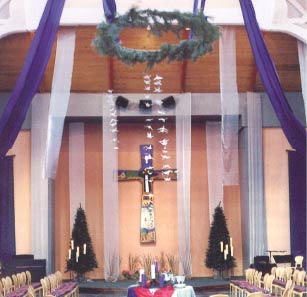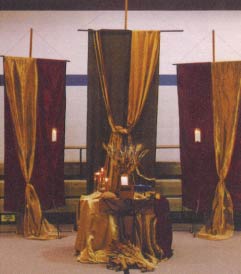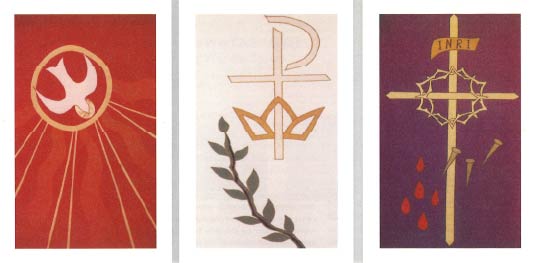Updated March, 2025
We seem to be in the midst of a sea change in attitudes toward the visual, even in worship. For one thing, since the middle of the last century, a major change has been taking place in our visual environment. Whereas previously print culture predominated, with the rise of television and movies we have entered an era in which visual images are dominant and inescapable. In seventeenth-century Puritan America, a person probably would have heard more than 5,000 sermons in his or her lifetime; by contrast, American children have probably seen more than 10,000 TV programs and a couple thousand movies by the time they are eighteen. No doubt they can tell you more about these videos than about any of the few hundred sermons they may have heard!
Whatever we think of this transformation, the dominance of visual imagery is not going to go away any time soon. The change has led to a generation of what are called visual learners—that is, people who learn best by seeing something illustrated rather than by simply hearing an explanation, people who think in images rather than in words. Around 60 percent of the population are defined now as visual learners (a fact that seems to be true across cultural groupings). These are the people we seek to reach and engage in worship. Whatever our views on contemporary culture, whether we like it or not, worship today has an inescapably visual aspect.
Looking Back
But paying attention to the visual environment of worship is decidedly not simply a concession to our culture. Worship has always included a visual dimension. Word and image have interacted throughout Christian history.
The rich sacrificial symbolism of Old Testament worship was enacted both in the tabernacle and temple and in the home. Consider the care with which God instructed Moses in the building of the tabernacle so that it would become a splendid worship space with carefully articulated colors and forms. The artists assigned were specially inspired by the Spirit of God for their exalted work (Ex. 31:1-5). When the temple was destroyed, the written Torah became the center of synagogue worship, but worshipers frequently lamented the loss of the lively temple traditions and longed for their restoration.
The New Testament treasured these traditions but altered them in the light of the earthshaking intervention of God in the person of Christ. Christ’s life was itself a dramatic journey from Bethlehem to Jerusalem—from birth to death, accompanied by the visual signs of his miracles and the stories that pictured the reign of God. Jesus’ last meal with his disciples was a dramatic anticipation of his sacrificial death in which he shared the broken bread with his disciples, announcing, “This is my Body.” From this point on worship would be defined by the presentation of this Body in word and image, as sinners were invited to come to the table.
Engaging the Senses
The question congregations need to ask today is whether the visual environment of our church engages the worshiper or is a deterrent to vital and biblical worship. Can attention to the visual space of worship encourage an appropriate engagement of the senses, one that directs and moves the heart toward God?
In the past decade, hundreds of churches across the denominational spectrum have given serious attention to these questions and have become convinced that visual elements can add important depth and support worship “in spirit and in truth.” Even in the Reformed tradition, where the preaching of the Word has been the focus and organizing principle of worship, a growing number of churches are recognizing that visual elements—spatial arrangements, movement and color—when appropriately used, can enhance the spiritual experience of hearing and receiving the Word of God.
Let us consider briefly the range of visual elements that churches have begun to use successfully.

Transformation of the Worship Space
Many congregations find themselves in worship spaces that do not facilitate interactive worship and that perpetuate patterns of worship that encourage passivity. Plans for renovation can give such congregations an opportunity to give attention to changing visual expectations. Mount Zion Lutheran Church in Pittsburgh, for example, found its century-old building unsuited for its changing congregation and newer liturgical practices. So, they enlisted the help of architecture students at nearby Carnegie-Mellon University to help them think through creative ways of using their space. They found that the process itself energized the congregation to think about their space in new ways and make it conducive not only for a renewed worship but for outreach to the community.
But even without a major renovation, much can be done to enliven the worship space. Banners have been popular in Protestant churches for almost a century—first coming into prominence in the revived worship patterns of Pentecostal churches. They provide a colorful and sometimes striking way to highlight liturgical seasons or special ministries in the church and, when the best artists available are involved, they can reach a high level of artistic expression.
More recently churches have begun to experiment with all kinds of hangings and draperies to literally transform their space. This can be done simply and easily. A pastor in an inner-city Methodist church in Illinois bought great bolts of bright red fabric to hang throughout the sanctuary in order to lighten an otherwise dark and imposing sanctuary. In Kansas City, Gary Duncan, minister of worship and the arts at St. Andrew Christian Church, has developed striking designs for sanctuaries that make use of hanging seven fashioning auditoriums for two recent Disciples’ General Assemblies (in Cincinnati and Kansas City) into lovely spaces for worship. Duncan has offered workshops in which participants—many of whom would never consider themselves artists—work together on designs for hangings that will enhance their own worship space. The potential for such celebrative hangings is rich, and the process of creating them has the added advantage of bringing artists and non-artists together to do creative work. The best practical guide for such work is Nancy Chinn’s Spaces for the Spirit: Adorning the Church (see, "Clip Art, Banner Designs, Books, and More").
Using Electronic Media
The growing practice of projecting images and videos onto screens placed in prominent places at the front of the congregation is a further example of visual imagery in worship. Many churches use such screens simply to enlarge the image of the speaker (or choir) or to show film clips during the service. But their artistic and creative potential goes far beyond that. Church of the Servant, a Christian Reformed church in Grand Rapids, Michigan, uses a white wall behind the musicians to project various images and designs that are integrated with the liturgical seasons and with hangings and banners used elsewhere. These images contribute a lovely bit of color that stands out in sharp contrast to the whiteness of the walls elsewhere.
Like many other churches, Good Shepherd Catholic Church in Cincinnati designed and constructed a large screen when it built a new sanctuary in the late 1970s. The screen is mostly used during the post-Communion meditation, during which images are rapidly projected, or videos are shown that celebrate the goodness of creation or the glory of God’s grace as portrayed in classical art. Images congruent with various readings enhance what the worshiper hears, and, along with music, can make the experience of worship exhilirating.
Clearly the use and capabilities of PowerPoint and similar computer programs make the projection of images and video easier and less expensive. This kind of technology is within the reach of many congregations. Moreover, there are sure to be young people for whom working in these media is second nature. This may be an important way to allow them to use their gifts to glorify God and thus draw them deeper into the life of the community.

Visual Artists in the Congregation
More and more frequently churches are recognizing the gifts of visual artists in their congregation. As the history of the church so amply shows, everything the congregation uses in worship provides an opportunity for creativity and beauty. The worship and arts team of the Lutheran Church of the Good Shepherd in Prospect Heights, Illinois, designed and produced special bulletin covers that were also made available as greeting cards as a part of its ministry. The colors and designs of the covers were coordinated with the seasons of the Christian year and with their liturgies. This same team also decorated church doors for various seasons and provided a processional cross for worship.
Daylesford Abbey in Paoli, Pennsylvania, in cooperation with the Calvin Institute of Christian Worship, brought together youth and adults from five different liturgical assemblies to the Abbey to create a significant piece of liturgical art. A creative liturgical artist directed the process in such a way that all participants had a greatly increased appreciation for the power of processional liturgy.
Many congregations have begun to see the potential of commissioning particular works of art to complement and enhance their worship. The Visual Arts Group at Coast Hills Community Church in Aliso Viejo, California, working with the pastor, offers works of art for various seasons that complement themes of projected sermons. These works are hung in the worship space and often projected on screens during the services, changing completely the visual space. For example, artist Wayne Forte contributed a series on the “Scarlet Letters” to accompany a series of sermons on the sayings of Christ. After these services the works are hung throughout the church to recall the worship themes.
Artist Marian Cornelison was commissioned to paint four large watercolors for the Advent season at Lake Avenue Congregational Church in Pasadena, California. The canvases—large figures of Mary, Gabriel, Anna, and Elizabeth, the strong diagonals nicely contrasting with soft, fresh watercolors—were placed on either side of the sanctuary. During the sermon on these figures the images were projected on a large central screen while the pastor used elements of the pictures to underline his points.
Finally . . .
These few examples illustrate that paying attention to visual elements need not distract from the central elements of worship—preaching, prayer, singing—but can enhance and accompany them with a kind of visual continuo. Heaven is often pictured as a place where all our gifts will be given over to the eternal and joyful worship of God. In this respect our worship on earth can surely anticipate that celebration.
We have much to learn in the use of art. While much moving and beautiful work has already been done, I am struck by the fact that the art we are making is almost always “temporary.” But at least we know that media is not about communication alone. Rather, it’s about enhancing and deepening our worship, and it must be used thoughtfully and prayerfully. Our commitment to that goal can create opportunities for people to work together, imagining spaces and colors that match and even enhancing the praises we sing and speak. And, in addition to nurturing the special gifts of artists in our congregations, we want to help others discover gifts of seeing and making that they might not otherwise have known they possessed. An excellent practical guide is Fiona Bond’s The Arts in Your Church (Piquant, 2001). This could be a wonderful way of encouraging our growing up into Christ in all things.


